
3-axis vs 4-axis vs 5-axis CNC machining
The comparison between 5-axis vs 3-axis CNC vs 4-Axis CNC machining touches on the fundamentals of part complexity, initial cost, maintenance requirements, expertise requirements, and cycle times. The manufacturer should dwell on such elements because they are different for each machine.
Of the three, 3-axis machining is the most basic, with only 3 linear axes of operation. The limited axes make it easier to use the machine, but expect it to take more time with multiple setups to make complex parts. Essentially, this is why the machine is most suited for parts of simple geometries.
As you move to the 4-axis CNC machine, a rotary axis is added, making machining of complex parts in one sitting a possibility. Part complexity increases even further in the 5-axis CNC machine, which has a pair of rotary axes on top of 3 linear axes.
The three machine designs are available in the market, but the specific one used for parts determines several important aspects. This is why understanding the capabilities, applications, advantages, and limitations of 4-axis vs 5-axis vs 3-axis CNC is critical.
Comparison of 5 Axis vs 3 Axis CNC machining vs 4 Axis CNC Machining is the core of this article. Read on for more insights.
What Are Axes In CNC Machining?
Axes in CNC machining refer to the directional movements in terms of the cutting tool versus the workpiece in a CNC machine. It is an important concept for manufacturers because it guides the machining approach a particular part requires, whether to apply multi-axis CNC machining or standard machining.
Linear Axes
These axes emanate from the Cartesian Coordinate System, a reference system in manufacturing. The basics of this system are the intersection of 3 mutually perpendicular axes, also called linear axes.
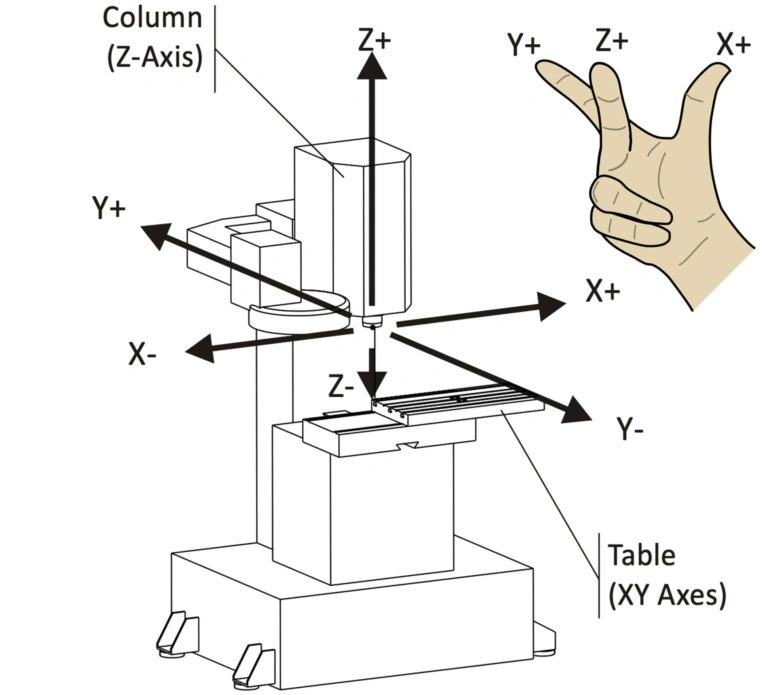
Cartesian coordinate system for CNC machines
Here’s what the linear axes signify;
X Axis: Right-to-left movement
Y Axis: front-to-back movement
Z Axis: Up-and-down movement
Rotary Axes
In CNC machining, there is another set of axes called rotary axes. The A axis, B axis, and C axis help improve the accuracy of the CNC machining process, specifically by increasing the angles at which the cutting tool can approach the workpiece.
They are called rotary axes because they rotate around the linear axes. Here is how the interaction looks:
A axis: Rotates or tilts around the X axis
B axis: Rotates around the Y axis
C axis: Rotates around the Z axis
How Many Axes Are There?
Most standard CNC machines have between 3 and 5 axes, but specialized CNC machines can have more. Some machines have as many as 9 axes, or even 12! The number of axes in a machine directly affects the possible part complexity and manufacturing capability of the machine.
What Is 3-Axis Machining?
The 3-axis CNC machining setup is characterized by a stationary workpiece and the cutting tool moving along three linear planes – X, Y, and Z. It is a fundamental machining style that still handles most of the part machining requirements. Its blend of cost-effectiveness and reliability is a big attraction to manufacturers.
As the 3-axis CNC machine diagram below shows, 3-axis CNC machining is not as complex as those with more axes.
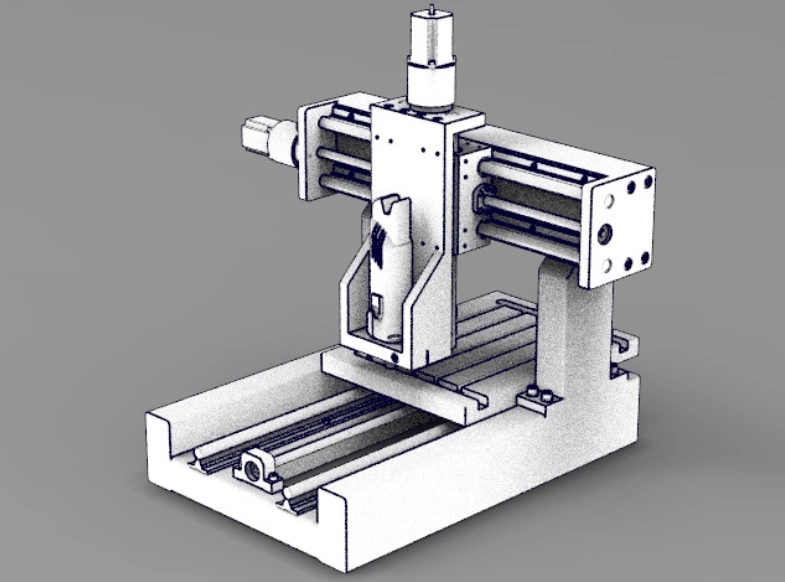
A 3-axis CNC machine diagram
What Can A 3-axis CNC Machine Do?
Manufacturers use the 3-axis CNC machine to produce foundational shapes and outlines, including flat surfaces, basic geometries, and contours. Some geometries doable on the 3-axis machine are CNC drilling, CNC facing, and CNC milling.
Here are some popular parts easily done on the 3-axis CNC machine:
- Plates
- Brackets
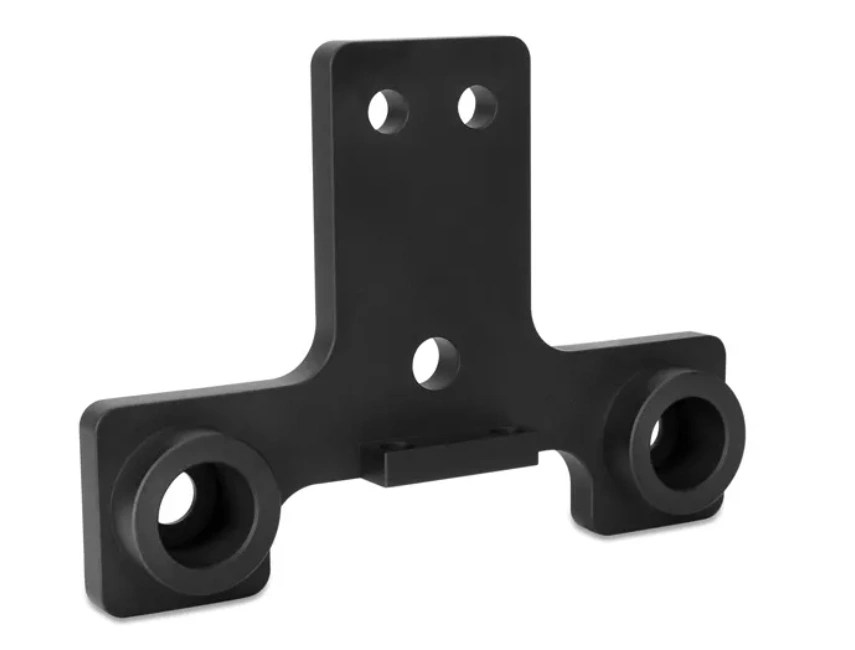
A 3-axis CNC-machined part
Try Prolean Now!
When to Choose 3-axis CNC Machining
Machinists opt to use 3-axis CNC machining when;
- The parts are flat and of simple geometry, for instance, plates, brackets, and housings
- The features are mostly on one side of the workpiece
- They want an affordable method for short runs and prototyping
- Tight tolerances are required, but not extremely complex
3-Axis Machining Advantages
- Easy to program and use
- Can be used for 2D cuts
- Relatively cost-effective
Limitations Of 3-axis CNC
- Unable to machine complex geometries
- Multiple setups required for complex parts
What Is 4-axis Machining?
While 3-axis CNC milling and other 3-axis machining methods stop at three linear axes, 4-axis machining goes a step further, adding a rotational movement around one of the linear axes. The effect of this addition is a reduction in multiple setup requirements.
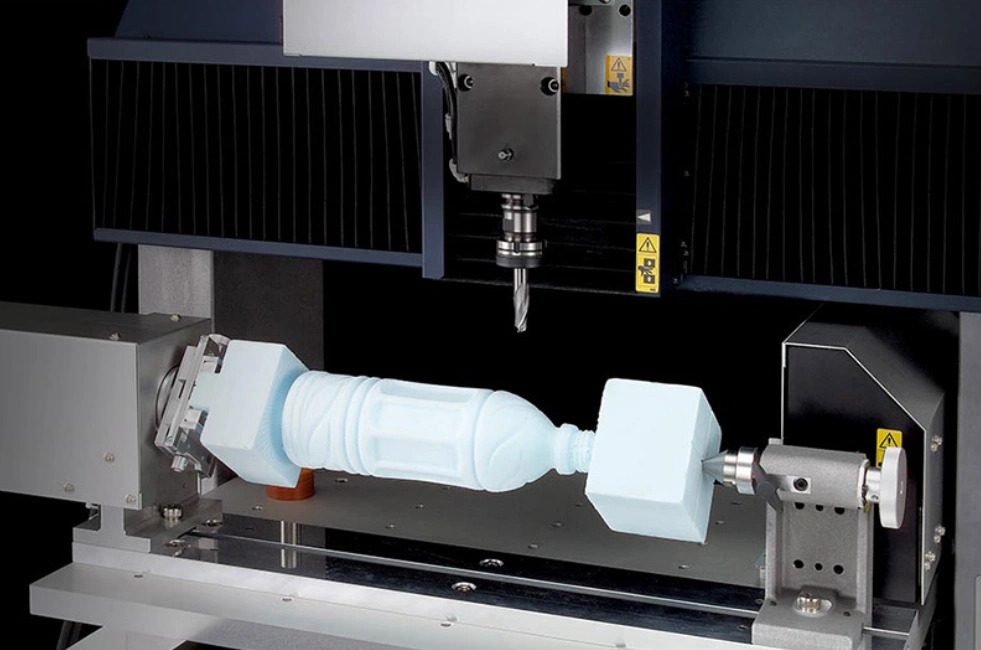
4-axis CNC machine
Specifically, 4-axis CNC machining introduces the capability to machine angled profiles and cylindrical shapes without multiple setups.
How Does A 4-axis CNC Machine Work?
The three linear axes work like they would in a 3-axis machine, but the fourth axis in 4-axis CNC machining rotates the cutting head or workpiece. These movements occur in coordination to enable the machine to produce complex profiles and shapes in a single setup.
When to Choose 4-axis CNC Machining
The 4-axis CNC machining approach is perfect when;
- Parts require machining at several faces in a single setup
- Parts are cylindrical
- Machining cycle times need to be reduced
- Intricate detailing is required

A 4-axis CNC-machined part
Advantages of 4-axis CNC Machining
- Higher accuracy and precision
- Less requirement for multiple setups
- More versatile than 3-axis CNC
Limitations of 4-axis CNC Machining
- Programming complexity is higher
- Higher upfront and running costs
What Is 5-axis CNC Machining?
There is an extra rotational axis in 5-axis CNC machining, bringing the total of these types of axes to 2. Therefore, there are three linear axes and two rotational axes in 5-axis machining.
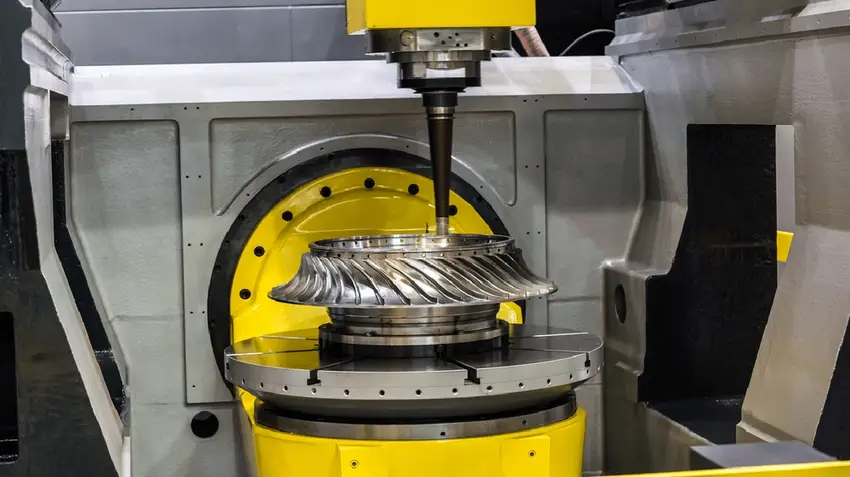
5-axis CNC machine
The effect of this additional rotational axis is immense; the cutting tool can approach the workpiece from almost any angle. A machine with this capability can manufacture more complex geometries faster, in one setting. It is the perfect machine for custom CNC machining services.
How Does 5 Axis CNC Machining Work?
The working process of the 5-axis CNC machine is straightforward but highly effective. All 5 axes work in coordination. The axes are engineered to work seamlessly and simultaneously for optimal machining, free of problems like cutting tool deflection.
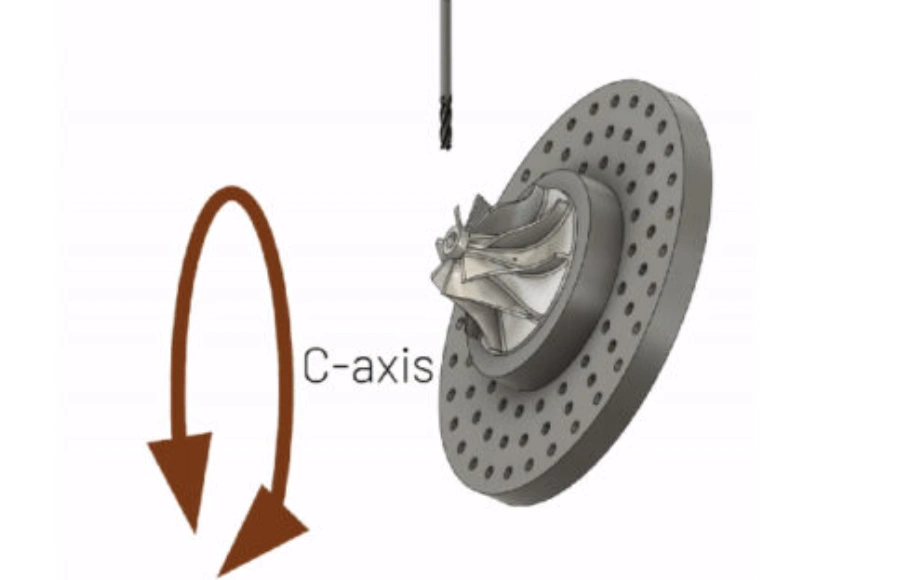
How 5-axis CNC machining works
The operation of the 5-axis machine is designed to significantly reduce the cycle time for intricate parts.
What Are The Tolerances For A 5-Axis Machine?
While 5-axis machines apply in tight tolerance machining, they do not provide absolute tolerances because the results are influenced by elements such as part complexity, machine integrity, and tooling quality. Generally, the tolerances for these machines are in the range of ±0.001″ to ±0.0002″.
At ProleanTech, tolerances from 5-axis machining services can be as low as ±0.0002″ (0.005mm). This means that the CNC machines can produce parts with superior surface finish, intricate shapes, and smoother curves, all in a single setup and with lower overall costs.
Try Prolean Now!
When to Choose 5-axis CNC Machining
As an exclusive form of CNC machining, the 5-axis level should be considered for;
- High precision parts with superior surface finish
- Disc parts for automobiles
- Multi-faced parts in a single setup, which are usually required for electronics
- Customized parts with special shapes

Custom complex 5-axis CNC-machined parts
Advantages Of 5-axis CNC
- Excellent surface finish and machining precision
- Easily performs complex CNC machining in one setup
Limitations Of 5-axis CNC
- High investment cost
- Requires highly skilled machinists
What Is The Difference Between 3-Axis And 5-Axis CNC Machines?
3-axis and 5-axis CNC machines have fundamental differences related to setup requirements, complexity of machined parts, and cycle times. 3-axis machines require several setups to machine a complex part that can be machined in a single setup by a 5-axis machine.
A 5-axis machine does this whilst also producing an excellent surface finish, which the 3-axis machine may not replicate.
The difference between 3-axis vs 5-axis CNC machining is evident from the difference in complexity of parts.
What Is 3+2-Axis CNC Machining?
Also called ‘positional 5-axis machining’, 3+2-axis CNC machining is a specialized method that blends the versatility of 5-axis CNC machining with the accurate milling capabilities of 3-axis CNC machining.
The cutting tool is placed in a fixed tilted position, and the worktable is left to rotate on two axes. In other words, the cutting tool is not manipulated during the machining process.
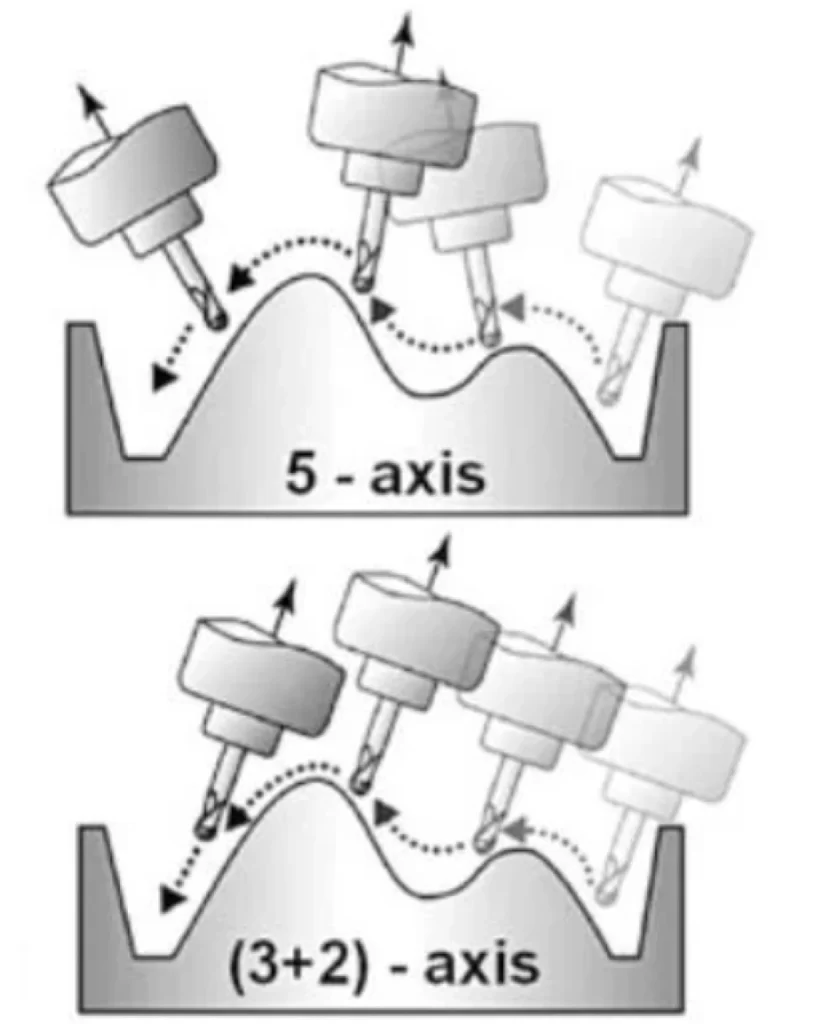
5-axis vs (3+2)-axis CNC machining
This approach is preferable when the cutting requires shorter, more rigid cutting tools.
What Is Simultaneous 5-Axis CNC Machining?
Simultaneous 5-axis CNC machining is different from 3+2-axis CNC machining in that it continuously manipulates the cutting tool during the machining process.
What Are The Differences Between 3-Axis,4-Axis and 5-Axis CNC
Similarly, 3-axis, 4-axis, and 5-axis CNC machines are different in several areas, such as initial investment, programming requirements, part complexity capabilities, machinist skill requirements, and programming level. A combination of these elements makes each of these types of CNC machines suitable for specific manufacturing environments.
| Element | 3-Axis CNC | 4-Axis CNC | 5-Axis CNC |
| Part Complexity | Flat surfaces, simple geometries | Curved profiles, cylindrical parts | Undercuts, angles, complex geometries |
| Setup Requirements | Frequent repositioning and setups for complex geometries | Fewer setups, machines cylindrical parts in a single setup | Minimal repositioning, complex parts in a single setup |
| Precision | Precision is limited to around ±0.005″ by multiple repositioning | Improved precision at about ±0.002″ | Superior precision of ±0.001″ |
| Investment | 3 axis machining services have low operating costs and an entry-level price | Moderate initial investment | High capital and maintenance costs |
| Production volume | High volume for simple parts | Medium volume for specialized parts | Low to medium volume for complex parts |
| Programming requirements | Fundamental G-code programming | Moderate programming complexity | Specialized programming skills required |
| Cycle time | Longer cycle time due to tool changes and setups | Shorter cycle time | Shortest cycle time for complex machining |
| Application Industry | Applications of 3-axis machining include 3D surfaces, plates, brackets, and flanges | 4-axis machining is applicable for simple and relatively complex parts such as impellers, crankshafts, and camshafts | 5-axis CNC machining makes complex parts such as turbine blades |
Factors to Consider When Choosing Between 3, 4, and 5 Axes in CNC Machining
The most important factors to consider when choosing between the three styles are versatility, programming requirements, accuracy, and cost.
The Versatility of The Machine
These machines are excellent at producing flat, basic parts, such as plates and brackets. However, the versatility of 3-axis CNC machining is limited when it comes to slightly more complex parts. For the highest flexibility in machining, consider using the 5-axis CNC system.
The Programming Requirements
Programming complexity goes hand-in-hand with the number of movements (axes) in a machine. Therefore, 5-axis CNC machining requires higher programming expertise than 3-axis and 4-axis CNC machining.
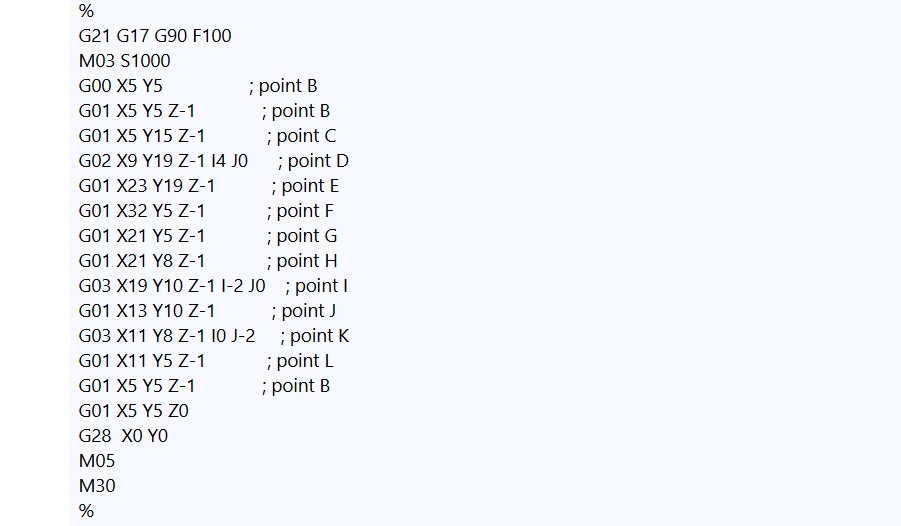
A simple CNC program (G-code)
The Required Machining Accuracy
While the three machines have incredible accuracy, the number of axes is ultimately the determinant of how much accuracy a machine can achieve. The highest accuracy is witnessed in 5-axis CNC machines, which can produce complex parts accurately in a single setting.
The Machining Cost
Fundamentally, the more complex the moves the cutting tool makes, the more expensive the process. That makes 3-axis CNC machining the most affordable and 5-axis CNC machining the least affordable of the three.
How Does The Number Of Axes Affect The Precision Of The Final Product?
The number of axes in a CNC machine has a big effect on the precision of the machined part or component. The higher the number of axes, the more degrees of freedom in the CNC machine.
For instance, in multi-axis machining services for a 5-axis CNC machine, two rotating axes allow the cutting tool to approach the workpiece at multiple angles. The CNC machining process is more accurate because the number of setups is markedly reduced.
Cutting force and heat are also reduced, meaning the possibility of machining the part as designed is very high. Process deformations are minimal, if any, so the surface quality and dimensional accuracy of the part are high.
Conclusion
Preparing a CNC machining design is only part of the job; you need to choose the right CNC machine and provider. Concerning the CNC machine, a major determinant of suitability is the number of axes, usually 3, 4, or 5 axes.
ProleanTech is ready to help you navigate this critical stage of the project, leveraging its wide technical knowledge, state-of-the-art CNC machinery, and experience serving a global clientele.
Request the best CNC machining services today!




0 Comments